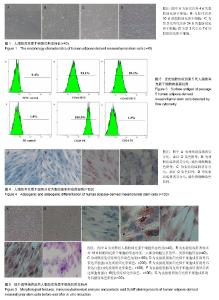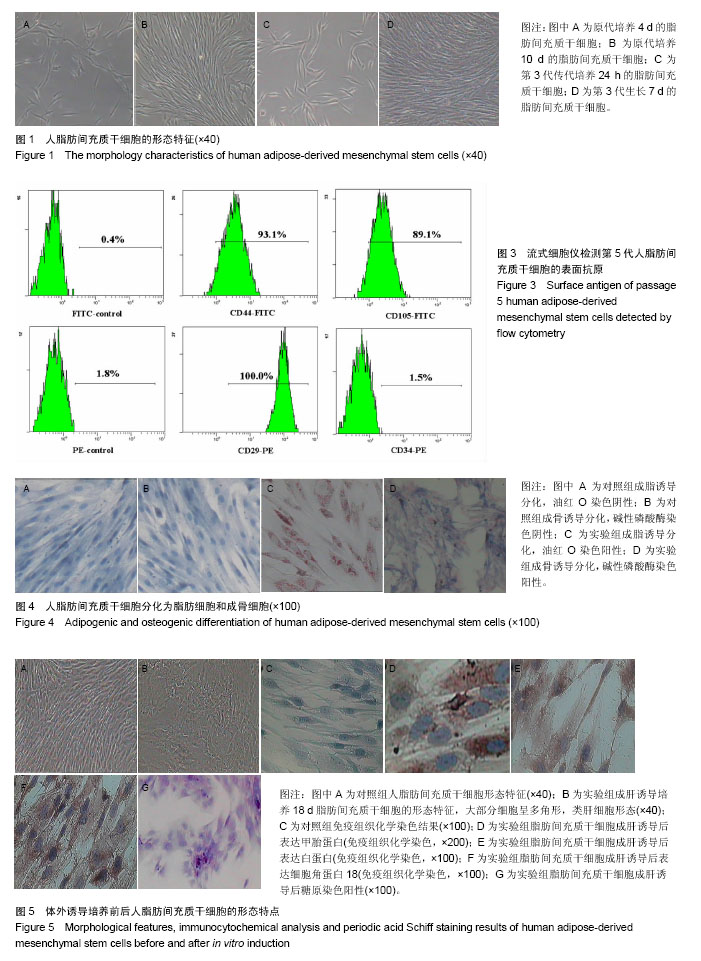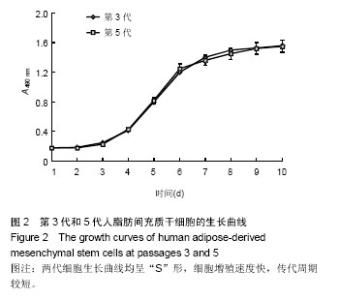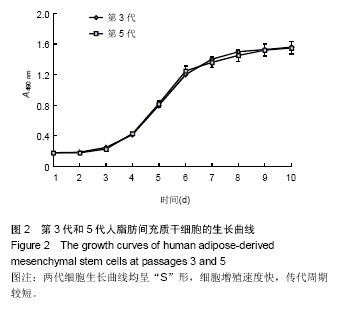| [1] 周新人,王方.干细胞治疗肝硬化进展[J].大连医科大学报,2013, 35(5):490-495.[2] Forner A,Llovet JM,Bruix J.Hepatocellular carcinoma. Lancet. 2012;379(9822): 1245-1255.[3] Jemal A,Bray F,Center MM,et al.Global cancer statistics.CA Cancer J Clin.2011; 61(2):69-90.[4] Liang X,Bi S,Yang W,et al. Epidemiological serosurvey of hepatitis B in China-declining HBV prevalence due to hepatitis B vaccination.Vaccine. 2009;27:6550-6557.[5] 宫铁红,刘玉乔,马艳丽,等.人工肝血浆置换治疗肝衰竭疗效观察[J].现代中西医结合杂志,2011,20(19):2374-2375.[6] 邢汉前,刘俊薇,王开利,等.持续缓慢血浆透析滤过治疗肝功能衰竭的临床疗效分析[J].生物医学工程与临床,2013,17(2):152- 155.[7] 张云巍,徐丽娟,王淑芳,等.人脂肪间充质干细胞体外诱导为肝脏样细胞的试验研究[J].首都医科大学学报,2014,5(35):608-615.[8] Krause DS,Theise ND,Collector MI,et al.Multi-Organ, Multi-Lineage Engraftment by a Single Bone Marrow-Derived Stem Cell.Cell.2001;105:369-377.[9] Pettenger MF,Mackay AM,Beck SC,et al.Multilineage Potential of Adult Human Mesenchymal Stem Cells.Science. 1999;284:143-147.[10] Woodbury D,Schwarz EJ,Prockop DJ,et al. Adult rat and human bone marrow stromal cells differentiate into neurons.J Neurosci Res.2000;61:364-370.[11] 殷莉波,赵文秀,尹震宇,等.体内外人脂肪间充质干细胞向肝样细胞分化的实验研究[J].中华肝胆外科杂志,2011,17(4):322-327.[12] Yang XF,He X,He J,et al.High efficient isolation and systematic identification of human adipose-derived mesenchymal stem cells.J Biomed Sci.2011;18:59-68.[13] Gruber HE,Somayaji S,Riley F,et al.Human adipose-derived mesenchymal stem cells: serial passaging, doubling time and cell senescence.Biotech Histochem.2012;87:303-311.[14] Zheng L,Chu J,Shi Y,et al.Bone marrow-derived stem cells ameliorate hepatic fibrosis by down- regulating interleukin-17. Cell Biosci.2013;3(1):46.[15] Monsel A,Zhu YG,Gennai S,et al.Cell-based therapy for acute organ injury: preclinical evidence and ongoing clinical trials using mesenchymal stem cells. Anesthesiology. 2014; 121(5): 1099-1121.[16] Volarevic V, Nurkovic J, Arsenijevic N, et al. Concise review: Therapeutic potential of mesenchymal stem cells for the treatment of acute liver failure and cirrhosis. Stem Cells. 2014; 32(11):2818-2823.[17] Zhong YS,Lin N,Deng MH,et al. Deficient proliferation of bone marrow-derived mesenchymal stem cells in patients with chronic hepatitis B viral infections and cirrhosis of the liver.Dig Dis Sci.2010;55(2):438-445. [18] Zuk PA,Zhu M,Ashjian P,et al.Human adipose tissue is a source of multipotent stem cells.Mol Biol Cell.2002; 13(12): 4279-4295.[19] Seo MJ,Suh SY,Bae YC,et al.Differentiation of human adipose stromal cells into hepatic lineage in vitro and in vivo. Biochem.Biophys Res Commun.2005;328:258-264.[20] 中华医学会肝病学分会,中华医学会感染病学分会.慢性乙型肝炎防治指南(2015版)[J].中华实验和临床感染病杂志:电子版, 2015,9(5):570-589.[21] 闵敏,张雪静,马红,等.人脂肪问充质干细胞的原代培养及体外成骨成脂诱导分化[J].江苏大学学报(医学版),2013,23(3): 185-190.[22] De Ugarte DA,Morizono K,Elbarbary A,et al.Comparison of multi-lineage cells from human adipose tissue and bone marrow.Cells Tissues Organs.2003;174:101-109.[23] Higashimoto M,Sakai Y,Takamura M,et al.Adipose tissue derived stromal stem cell therapy in murine ConA-derived hepatitis is dependent on myeloid-lineage and CD4+ T-cell suppression.Eur J Immunol.2013;43(11):2956-2968.[24] Lee JH,Lee KH.Possibility of undifferentiated human thigh adipose stem cells differentiating into functional hepatocyte. Arch Plast Surg.2012;39:593-599.[25] Strioga M,Viswanathan S,Darinskas A,et al.Same or Not the Same? Comparison of Adipose Tissue-Derived Versus Bone Marrow-Derived Mesenchymal Stem and Stromal Cells. Stem Cells Dev.2012;21:2724-2752.[26] Wosnitza M,Hemmrich K,Groger A,et al.Plasticity of human adipose stem cells to perform adipogenic and endothelial differentiation.Differentiation.2007;75:12-23.[27] Eom YW,Lee JE,Yang MS,et al.Rapid isolation of adipose tissue-derived stem cells by the storage of lipoaspirates. Yonsei Med J.2011;52(6):999-1007.[28] Priya N,Sarcar S,Majumdar AS,et al.Explant culture:a simple, reproducible, efficient and economic technique for isolation of mesenchymal stromal cells from human adipose tissue and lipoaspirate.J Tissue Eng Regen Med.2014;8(9):706-716.[29] Jing W,Xiao J,Xiong Z,et al.Explant culture: an efficient method to isolate adipose-derived stromal cells for tissue engineering.Artif Organs. 2011;35(2):105-112.[30] Markarian CF,Frey GZ,Silveira MD,et al.Isolation of adipose-derived stem cells: a comparison among different methods.Biotechnol Lett.2014;36(4):693-702.[31] 刘子琪,孙同文,万有栋,等.脂肪源性干细胞体外分离培养及向内皮祖细胞的诱导分化[J].中国组织工程研究,2015,19(32): 5182-5187.[32] Maumus M,Peyrafitte JA,D’Angelo R,et al.Native human adipose stromal cells: localization, morphology and phenotype. Int J Obes.2011;35:1141-1153.[33] Crop M,Baan CC,Korevaar SS,et al.Human adipose tissue- derived mesenchymal stem cells induce explosive T-cell proliferation.Stem Cells Dev.2010;19:1843-1853.[34] Talens-Visconti R,Bonora A,Jover R,et al.Hepatogenic differentiation of human mesenchymal stem cells from adipose tissue in comparison with bone marrow mesenchymal stem cells.World J Gastroenterol. 2006;12: 5834-5845. [35] Chivu M,Dima SO,Stancu CI,et al.In vitro hepatic differentiation of human bone marrow mesenchymal stem cells under differential exposure to liver-specific factors. Transl Res.2009;154(3):122-132. |



